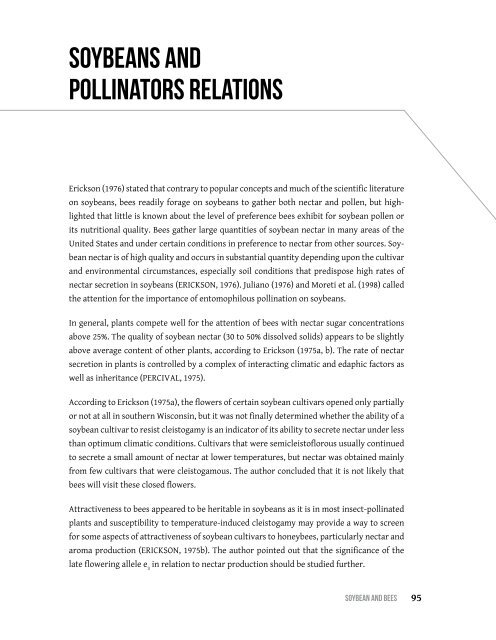Soybean and Bees
You also want an ePaper? Increase the reach of your titles
YUMPU automatically turns print PDFs into web optimized ePapers that Google loves.
<strong>Soybean</strong>s <strong>and</strong><br />
pollinators relations<br />
Erickson (1976) stated that contrary to popular concepts <strong>and</strong> much of the scientific literature<br />
on soybeans, bees readily forage on soybeans to gather both nectar <strong>and</strong> pollen, but highlighted<br />
that little is known about the level of preference bees exhibit for soybean pollen or<br />
its nutritional quality. <strong>Bees</strong> gather large quantities of soybean nectar in many areas of the<br />
United States <strong>and</strong> under certain conditions in preference to nectar from other sources. <strong>Soybean</strong><br />
nectar is of high quality <strong>and</strong> occurs in substantial quantity depending upon the cultivar<br />
<strong>and</strong> environmental circumstances, especially soil conditions that predispose high rates of<br />
nectar secretion in soybeans (Erickson, 1976). Juliano (1976) <strong>and</strong> Moreti et al. (1998) called<br />
the attention for the importance of entomophilous pollination on soybeans.<br />
In general, plants compete well for the attention of bees with nectar sugar concentrations<br />
above 25%. The quality of soybean nectar (30 to 50% dissolved solids) appears to be slightly<br />
above average content of other plants, according to Erickson (1975a, b). The rate of nectar<br />
secretion in plants is controlled by a complex of interacting climatic <strong>and</strong> edaphic factors as<br />
well as inheritance (Percival, 1975).<br />
According to Erickson (1975a), the flowers of certain soybean cultivars opened only partially<br />
or not at all in southern Wisconsin, but it was not finally determined whether the ability of a<br />
soybean cultivar to resist cleistogamy is an indicator of its ability to secrete nectar under less<br />
than optimum climatic conditions. Cultivars that were semicleistoflorous usually continued<br />
to secrete a small amount of nectar at lower temperatures, but nectar was obtained mainly<br />
from few cultivars that were cleistogamous. The author concluded that it is not likely that<br />
bees will visit these closed flowers.<br />
Attractiveness to bees appeared to be heritable in soybeans as it is in most insect-pollinated<br />
plants <strong>and</strong> susceptibility to temperature-induced cleistogamy may provide a way to screen<br />
for some aspects of attractiveness of soybean cultivars to honeybees, particularly nectar <strong>and</strong><br />
aroma production (Erickson, 1975b). The author pointed out that the significance of the<br />
late flowering allele e 3<br />
in relation to nectar production should be studied further.<br />
SoybeAn <strong>and</strong> bees<br />
95


